Welcome to another week, when we hope to bring you some interesting, thought provoking, and fun things to take part in. Now there is a bit of a change this week as we are adding in some hashtags. This will let you join in with the event on social media, and, as always, please tag in @Card_World with everything you tweet related to cards, or collecting!
Another change is that I discovered quite by accident, that there is an official way to code many of the early reference books, or more correctly the ones which have numbers for each set, so instead of my rather clunky P/, followed by the number, say 127, I should have been citing them as RB.17/127. These will, one day, all be changed, but hopefully by the next edition there might be a short piece written about the codes and what they stand for.
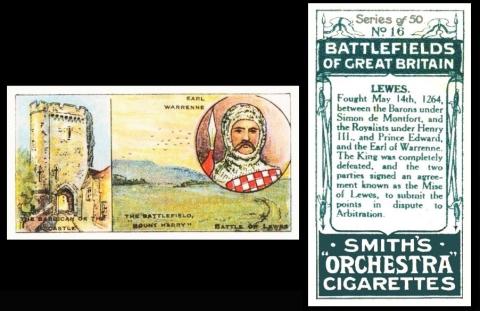

F & J SMITH [tobacco : UK] “Battlefields of Great Britain”- "Orchestra Cigarettes" brand (1913) 16/50 - S548-050 : S84-2 : Ha.475
Today, in 1264 the Battle of Lewes was fought on Mount Harry, in what was known as the Second Barons' War.
Simon de Montfort, Earl of Leicester, commanded the Barons, and they defeated the Royalists, Prince Edward, the Earl of Warenne, shown on this card, and, you may think, most startlingly, the King of England, Henry III. who, as the card tells us "...was completely defeated”. However, he was not the last King of England to physically lead troops into battle, that rather dubious honour going to King George II, about five hundred years later, when he commanded the British Army, against the French, at the Battle of Dettingen in 1743. More than that, he was sixty years of age at the time.
Today Lewes is just a small town with a rather good auction, Wallis and Wallis, who mainly sell militaria and toys. but also sometimes cards, both trade and cigarette, and postcards. However, in much earlier days there had been a lot of standing to Lewes. This is backed up by Players “Celebrated Gateways” (P644-056 : P72-73 : RB.17/44 : H.347 ~ September 1909) 3/50 - a set which was also issued by Churchman (C504-440 : C82-38 : Ch/30 : H.347 ~ April 1925). These say that Lewes had “been a place of importance under the Romans” and that “The Lordship of Lewes was given by William the Conqueror to William de Warenne, Earl of Surrey, who built the castle and the walls”.
If you are in the area, or fancy a drive in the country, the battle is re-enacted over this weekend on the sites it happened.
This card is yet another of the multibacks that we feature on the homepage for this set, which you can see as out Card of the Day for the 12th of October 2021
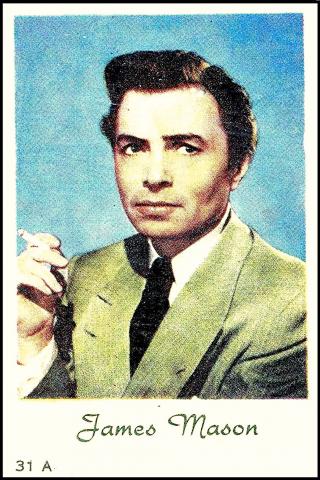
Today in 1909 James Neville Mason was born in Huddersfield, West Yorkshire.
He started out on stage, making several appearances at the celebrated Old Vic, then in the early 1930s he started appearing in front of the camera. Though he was reportedly sacked by Alexander Korda early into one of his first roles, he did not hold a grudge and James Mason appeared to great effect for him again in the Alexander Korda film Fire Over England, released in 1937.
He was also one of the first stars to appear on television, in some screenings of selected stage productions. In fact he was top of the box office popularity list in the later years of the Second World War and early post war period, my favourite would definitely be Odd Man Out (1947), and then he moved to America in 1949.
At first he was miscast, or appeared in films that did him no justice. The turning point was when he played Erwin Rommel in the Desert Fox, and after that he appeared in many top movies, right in to the 1970s, though I have to say it is only when you read the credits that you really notice him, for his was a quiet presence, often serious and thoughful, not given to loud displays which the audience remembered for some while after leaving. Actually he played Rommel twice, the second being in The Desert Rats (1953). He was never type cast though, and starred to great effect opposite Judy Garland in probably the best known remake of A Star is Born. He was also in Lolita (1962), for which he took some criticising, but he believed the role was too good to turn down. which he also produced.
One thing that is seldom discussed is his great love for silent movies. He worked with many researchers and film makers in trying to preserve the past and ensure it was visible for the future. This was undoubtedly enhanced by finding out that one of his homes had once been owned by Buster Keaton. In fact he donated many of the artefacts, and some discarded film reels he discovered, to researchers and museums. And at another time he lived next door to Charles Chaplin, a long term friend.
#JamesMason
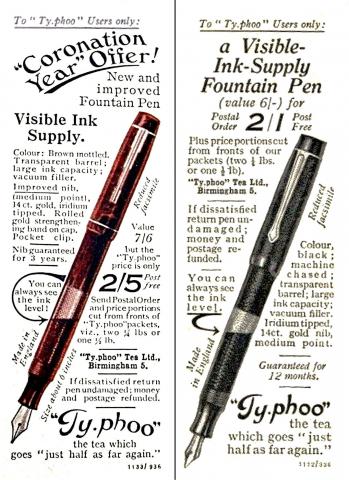
May 16 – 22 will be National Stationery Week. It was a choice between this and Vegetarian Week but in the end I thought that I could find more examples of vegetarianism than stationery. Turns out I was wrong, but at least I nailed my personal vegetarianism to the mast. Again.
The first thing I think of in the stationery cupboard is the pen, which gives me a chance to chat about a great web-page I found when I started looking into this, with loads of links. This relates to the pens which were given away by Typhoo Tea in the 1930s
Strangely you did not send cards for the pen, just the price portions cut from the fronts of the packaging, (either two off the quarter pound packs, or one off the half a pound packs – from which you can tell this was loose tea, not bags). You also had to send a postal order, but the cost varied.
Two of the most popular pens are shown here, off the backs of the long cards that Typhoo specialised in. These are the standard black with the clear ink level indicator section, which was a penny over two shillings, and the browny red “Coronation” pen at two shillings and fivepence. Post was free.
Dare I say, these pens were inex-pen-sive but they were not cheaply manufactured, they had large ink capacities and medium point nibs in 14 carat gold with iridium tips.
On some models there was an additional rolled gold band on the cap to prevent it splitting under extreme usage.
@NatStatWeek - tags are #NatStatWeek and #writingmatters
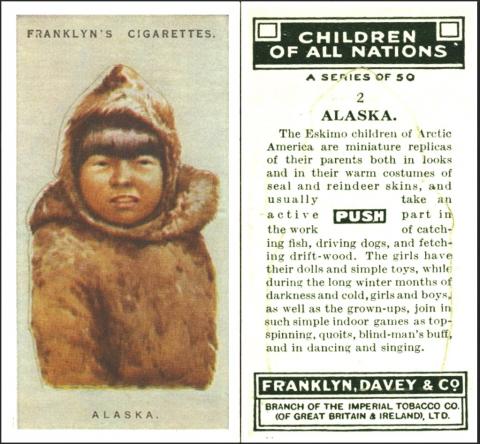
Today in 1884 it is sometimes said that Alaska became an American Territory. Before we tackle that, which is not entirely correct, lets have a chat about the fact that at one time Russia had actually owned Alaska, which since 1784 had been known, curiously, as Russian America, but they had sold it to America in 1867, very cheaply, because it was hard to protect, and for the simple reasons that most of it was unusable, it was too cold, the ground too hard, and they thought few people would be interested to live there, though curiously some Russians had been living there. You can read more about this at opindia.
I say “very cheaply”, and per acre it was, but there are a lot of acres in Alaska, and the price was close to $7.2 million.
After the sale Russian America disappeared, and it was renamed the Department of Alaska, this lasted until our date, today in 1884, when it became the District of Alaska. This was changed on August 24th, 1912, to The Territory of Alaska. And it became the 49 th State of The United States on January 3rd, 1959.
As to how Alaska got its name, it was from the name of the large peninsula “Oonalaska”, and some believe that at one time it was going to be the entire word, but they just took the end. However Alaska itself is a corruption of the Inuit word Alaxsxaq which technically means a mainland. Another suggestion was to call it Yukon, after the most prominent river.
The first inhabitants, in prehistoric times, simply walked across the sea and settled. They would have looked like our card – Franklyn Davey “Children of All Nations” cut outs (F756-530 : F52-22 : RB21/200-168E ~ 1934) 2/50 for many centuries, wrapped against the inclement weather, though according to the card it was a fun existence, (apart from the seal and reindeer skins, of course) for it speaks of the children “driving dogs and fetching driftwood”...of “dolls and simple toys”.. and of “simple indoor games [such as] top-spinning, quoits, blind-man`s buff, and in dancing and singing”. I fear it was a much harder life than that, but, as always, hope for better.
It is not known how much of the sale money for Alaska went to their descendants, either given to them directly, or used to improve their health and welfare. But I doubt it was any.
#Alaska
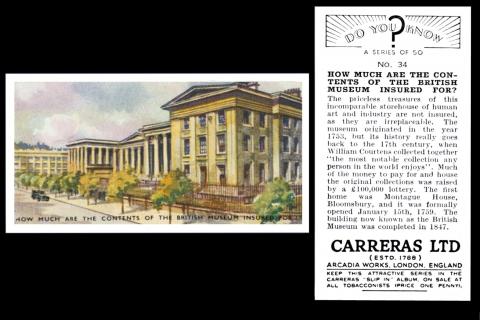
International Museum Day is a global day celebration that takes place annually around or on 18 May.
Cards of museums, or museum artefacts are many, however, cartophilists will, or should, immediately think of the British Museum, wherein lies the fantastic collection of our former President Edward Wharton Tigar.
The really curious thing about the British Museum is on our card, Carreras “Do You Know” (C151-230 : C18-39 ~ 1939) 34/50, for this poses the question “How Much are the Contents of the British Museum Insured for?” Now this would be a good question for a pub quiz, because immediately you go in knots trying to value everything, and come up with a truly vast figure.
However, on the reverse, it tells us that “The priceless treasures of this incomparable storehouse of human history are not insured, as they are irreplaceable”. Surely this is not still the case?
Anyway after that bombshell the card tells us the story of the British Museum; that it comes from one collection, that of William Courtens, in the 17th Century, and that it became a museum in 1753, and that the money to buy and house the original collection was raised by means of a lottery. A really fascinating card.
How to celebrate International Museum Day? Well every town has a local collection of artefacts somewhere, so find out where this is and nip along. Not all of them are open all hours, for they generally depend on volunteers to staff them and to do other jobs besides, mending, researching, fund raising.
And if you would be interested in helping with that, why not just ask?
@britishmuseum and #IMD2022
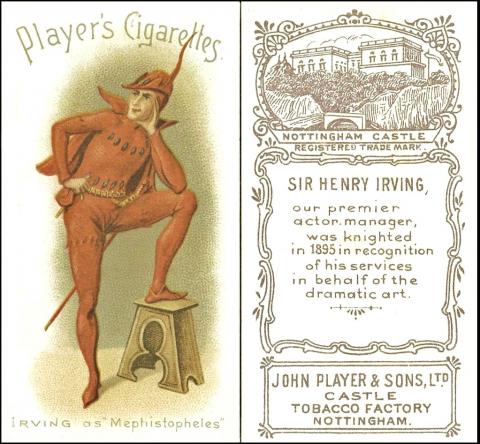
John PLAYER [tobacco : UK - Nottingham] "Actors & Actresses" (1898
Let`s cut a slice on National Devil’s Food Cake Day. Actually it is just a very rich chocolate cake that uses cocoa and sometimes even coffee. It’s the sort of cake that you always look straight at when you go to a restaurant, but usually resist. Or try to. Well today, be a Devil and order it!
Now here are a few things you didn’t know about this treat. Firstly, it was often offered with its alter ego Angel Food Cake. Secondly, it was on the menu before 1900, hence our early John Player “Actors and Actresses” (P644-005 : P72-1 : RB17/1 : H.337 ~ 1898) card of the Devil, or Mephistopheles, as played here on the stage by Henry Irving. This card has a short text, one of the first to do so, and it gives the date of the knighthood as 1895.
The original cards are sadly not very colourful, I have tried my best to zhush it up, but the devil costume still looks quite brown, whereas it would surely have been a very bright red to stand out on the stage from even the furthest distance; also early memoirs speak of people shrieking with fear and delight to see any form of devil on stage, which would not have been the case in such a dull attire.
Strangely enough, movies soon discovered that the opposite was true, that red did not film well, and that the most stunning red could only be obtained by making the actors or actresses wear brown.
#DevilsFoodCakeDay

Every year on the third Friday in May, since 2003, a branch of motor racing called NASCAR (The National Association for Stock Car Auto Racing) has a special event to thank the fans and support the drivers and sponsors, as well as raise money for children’s charities.
You may not have heard of NASCAR, unless you have cable or satellite television, for it is an American branch of the sport, curiously called Stock Car Racing, but it is much unlike our home grown races of that name where the racers drive their vehicles almost to the point of destruction, and some beyond.
The first NASCAR race was in 1948, at Daytona. And the first trading cards were issued forty years after, in 1988, by a company called Pinnacle, who set off from the start at a sterling pace, eventually making so much money that they were able to buy Donruss, thirty years their senior.
They also had great ideas, introducing “Rookie Cards” in 1994 for every incoming driver; some of these cards, for drivers who went on to win championships, or drive in other branches of motor sport, are very sought after today.
Unfortunately the boom went bust, as it so often does, and in 1998 Pinnacle was bankrupt, their assets being picked over by others.
And Donruss went to Panini.
This is a very unusual card, anyone know more about it?Do let us know. And look out for that story on Twitter
#NASCARDay
This week's Cards of the Day...
This week we will be looking forward to National Vegetarian Week which runs from the 16th to the 22nd of May.
Saturday, 7th May 2022
![NEW-310 : NFK.4 [trade : UK] News Chronicle “Soccer Players” untitled - Northampton Town Squad, (8 October 1955) Un/12](/sites/default/files/styles/content_aligned/public/2022-05/07%20yeoman.jpg?itok=YjgeIcMP)
The clue here was the footballer`s surname, Yeoman, which means a farmer, but traditionally one who owned the land they farm, rather than renting or just working on it for someone else, and whose food was mostly used by the family themselves. This actually raised them in the class structure, and allowed them to vote in elections, but crucially it also gave them greater control of how and what they used for growing and fertilising, and they would often farm in a more basic, earth friendly manner, allowing animals and birds to assist with pollination and pest control; whereas farmers with large acreages were apt to try and raise the most crop out of the smallest area, using outside workers, and not having time to let nature do any of the work.
A yeoman was therefore seen as hardworking, and respectful of his ground. This is why the name, once forgotten, has come back and is often used for eco-friendly foods and food box ordering systems.
The “R” stood for Ray, and Ray Yeoman was born in Perth, rather coincidentally on the thirteenth of this month, in 1934.
He was actually Scottish, born in Perth, and his first team was Newburgh, moving from them to St. Johnstone in 1950 and moving south of the border three years later. He left them in 1959 for Middlesborough, and then went to Darlington in 1964, later managing their squad. He died in 2004.
He does not seem to have appeared on many other cards, but we found two - Philip Neill Collectables “Soccer Stars of the 50s” (2001) 4/10 - and – J F Sporting Collectibles “Footballers 1950s” first series 35/48, which shows him at Middlesborough
Our card is from a large and interesting group, split into sets of twelve cards, a club squad on each. The News Chronicle was a newspaper, which had some association with the “Daily Dispatch” (aka “Dispatch”), and you can find some cards which have both newspapers on the front header.
Our cards were issued in the 1950s, and they are black and white halftone studies of sportsmen, medium sized and slightly variable in it with the cards being between 82-86 m/m x 58-61 m/m. They are un-numbered but first appear in our British Trade Index Part Two, issued in 1969, where they are alloted numbers, this card’s full code then becomes NFK-4.30.12. However in the new British Trade Index, our cards were renamed to “Footballers” and given the code NEW-310, this makes our card NEW-310.30. However the index does not tell the names of the footballers, as these have been moved to the Handbook, where we find our man is now NEW-310.30.12.
By the way the other sportsmen sets cover cricket, motor cycling, and rugby, plus a twelve card set about Stirling Moss, which, like our card, was promotion for the paper, and declares that “The Story of Stirling Moss Begins on Monday, June 6th in the News Chronicle”. However this set is very important in race car-tophily, because one of the cards shows Stirling Moss at the Prescott Hill Climb, in a 500cc Cooper – and this was his first ever hill climbing event, in May 1948, though that branch of motor sport was in his blood from his mother, who used to compete in them before the Second World War.
Most of the News Chronicle cards were issued in the 1950s but there is a strange exception, or two, as in the 1930s it had issued cards which were given the name of “Soccer Teams”, these were on art paper, and the only one known at the time of our original British Trade Indexes was “Fulham F.C. 1935-36”. This is much larger than cigarette cards, measuring 383 x 255 m/m, and it seems likely that it would be more possible for us to find any others that exist in the collections of ephemera and football collectors. So if you have any others do let us know. More curiously, this Fulham card does not appear in our more modern Trade Index update, but there is a similar item, also untitled, and given the set title “Football Teams”. The subject on this is Arsenal F.C. 1934-35. It measures 300 x 210 m/m, which is a bit smaller but to me there is this immediate aura of a possible connection, that ought to be chased.
Sunday, 8th May 2022
![P521-438 : P50-105 : Ph/68 [tobacco : UK] Godfrey Phillips “Famous Minors” (1936) 5/50](/sites/default/files/styles/content_aligned/public/2022-05/08%20leonardo%20%282%29.jpg?itok=SnG0k7Dr)
This may have caused some pondering with you all, but it is strongly believed by some that Leonardo Da Vinci was vegetarian, perhaps even vegan, and this comes from letters, written in his own hand, which you can read more about at many sites, including The International Vegetarian Union and Bitesize Vegan
I imagine he would not have been too happy to realise his person was being used to encourage the purchase of Liebig cards, which were issued with meat extract, including this one
Strangely other than Liebig, he is seldom featured on cards – though he is on British American Tobacco Domino brand “Figures Historiques” second series (B705-556.2 ~1961) 6/25 – and on Brooke Bond tea “Inventors and Inventions” (1975) 6/50. His great work, the Mona Lisa, fares a little better, for she appears on W.D. & H.O. Wills “Art Photogravures” (W675-550 : W62-397 : W/43 ~ 1912/13) 5/50 – R & J Hill “Famous Pictures” (H554-335 : H46-26 : H.468 ~1913) 2/25 - John Player “Miniatures” (P644-230 : P72-111 : RB.17/127 ~ June 1923) 1/25 - and on Coopers Tea “Mysteries and Wonders of the World” second series of 25 (1961) number 35 (the mystery and wonder being that her eyes seem to follow you around the gallery as you walk).
Then there is a rather weird one, Barratt “Merchant Ships of the World” blue back (1962) where card 24/25 is the S.S. Leonardo da Vinci. There were several ships by this name but the text tells us our one was the latest addition to the Italia Line, making her maiden voyage on June 30, 1960, and being the largest liner built in Italy since the last war. This makes her the replacement for the SS Andrea Doria, which collided with the MS Stockholm on July 25, 1956.
Our original Godfrey Phillips reference book, RB.13, dating from 1949, and originally costing 8/6d, tells us that this set is “small cards, size 67 x 37 m/m. Fronts printed by letterpress in colour. Backs in brown, with descriptive text, adhesive. Issued 1936”
These were similar to the Phillips set of “Famous Boys” (P521-320 : P50-57 : Ph/63 ~ 1924)
Monday, 9th May 2022
![C151-190 : C18-31 [tobacco : UK] Carreras Ltd “Amusing Tricks and How To Do Them” (January 1937) 32/50](/sites/default/files/styles/content_aligned/public/2022-05/09%20egg.jpg?itok=ZAgc6hzh)
These have all been rather hard associations but I hope they have made you think.
This one is a trick in more ways than one, for eggs are a major confusion in the vegetarian and vegan world, and many people believe they can eat eggs (and milk) and still be a vegetarian, in fact there is a word for this, they become a “lacto-ovo-vegetarian” (lacto being the milk and ovo being the egg). Others believe that they can eat the white and that is ok, but draw the line at the yellow, from which the chick arises. I have always been glad of our dogs, for when my mum used to cook eggs and present them as dinner I could slide them secretly down into their waiting mouths. I have never liked eggs.
Milk has also been troublesome to my constitution, but I recently abandoned it entirely, and things are going well.
This card is a total trip back into time, for where now would you get wax, apart from for a surfboard ? And who now wears waistcoats ? Strangely, the picture does not appear to show the man in a waistcoat, it is more like just a standard short coat. However the children are very 1930s, the girl in her “shy girl” pose, so reminiscent of those fairground chalk figures, and look at the tall boy in his dress suit with the bow tie.
Another question here is who is the artist? Anyone out there know? They sign the card, on the front, so they must have been of some importance, but they are not listed on the back. It would be nice to give them a bit of presumably posthumous fame.
These cards were listed in the London Cigarette Card Catalogue for 1950 at 1½p a card and 5/- a set, but there was the crossed o symbol following to show they were cheaper in the Abridged Catalogue. The logistics of adding up penny ha`pennies is quite beyond me, as are most attempts to work with numbers, that is why all my sales labels are in round pounds!
Tuesday, 10th May 2022
![W675-180.A : W62-142.A: W/226 [tobacco : UK] W.D. & H.O. Wills "Garden Hints" (January 1938) 31/50](/sites/default/files/styles/content_aligned/public/2022-05/10%20potato.jpg?itok=oC7GY1qh)
According to YouGov, 99% of people knew a potato when shown one, and it was the most popular vegetable with 90% of those asked.
Potatoes are the unsung heroes of a vegetarian diet, though actually potatoes plainly cooked with no butter are vegan; it is the topping that converts them to the other side. They are also high in carbohydrates, Vitamins C and B6, and potassium.
This set was also issued in Ireland (same codes as above but followed by b) and in the Channel Islands (for which the code in our latest World Tobacco Issues Index is W675-710). and the Irish version is almost the same except there is no price given for the album, and the Channel Islands version has no mention of album nor Imperial Tobacco.
The "A" in our code is for the Home issue, which mentions the Imperial Tobacco Company, and has an album clause at the top giving the price of one penny. Then there is an Irish version, with a "B" suffix, which has the clause but no price is quoted for the album. There is also a "C" in the original Wills Reference Booklet part IV, this was a Channel Islands issue, and had simply the frameline without mentioning either the I.T.C. or the album.
The potato is one of the easiest items to grow, and does not require a garden. The next time you forget to eat the one at the bottom of the potato barrel, and it has grown shoots, get a bucket and put some soil in it, burying the potato in the bucket, then wait for the green leaves to come out of the soil and bury them in more soil. Eventually the leaves will start to turn yellow, and then you can harvest, for the roots will carry small versions of the potato you planted. And next year you will want to do it all again!
By the way proper gardeners say you should only leave two or three green shoots and rub any others off. But that takes a harder heart than mine, who hates to see any form of effort going unrewarded.
Wednesday, 11th May 2022
![ZA08-340 : ZA8-18.2 : RB21/287 [tobacco: UK] Anonymous "Guernsey, Alderney & Sark - Past and Present" medium (1938) Un/48](/sites/default/files/styles/content_aligned/public/2022-05/11%20guernsey.jpg?itok=f6LKhu7S)
Here is another amusing vegetarian fact, a tomato is actually a fruit, but it is classed as a vegetable. It all came from a decision, as high up as the Supreme Court in America, which called them a vegetable, for the purpose of taxation. There seems to be rather a lot of connection between this fact and the knowledge that the tomato is the most popular vegetable worldwide.
These were issued through British American Tobacco, and it does seem strange that they never put their name on them.
The cards are said to be sepia photos, with hand colouring added after the printing, but some are dark and could easily be mistaken for black and white. There are two series, both this size, 77 x 64 m/m and both of 48 cards; the first series is partly hand coloured, meaning that not all cards were; in fact in our original British American Tobacco reference book, RB.21, it tells us that only four cards were not coloured, these being cards 16 (Royal Court House, Guernsey), 43 (St. Sampson`s Harbour), 44 (Rocquaine Bay, Guernsey) and 45 (St. Peter Port). However the second series, ours were all hand coloured.
I like the clothing on this card, some are wearing aprons as if it were a normal day, and then you get the lady in black on the right, with her best hat, and wearing buttoned and heeled shoes. I bet her feet hurt all night when she got home.
Sadly none are known to us as to their names, or what they did outside work for pleasure and entertainment; their only proof of life may well be this card, and it has not yet been brought to the attention of their relatives. If I had more time it would be fun to tweet, or maybe instagram, cards like this, showing the lives of these unknown people; I have a whole box of military photos that I rescued from going unsold at an auction, fearing they might end up in the skip, and my intention is to show those on the socials and reunite them with their futures, but getting the time is hard, there is the sorting and the scanning, and the even scant researching so I get the right regiment and catch the eye of the people who only search for that. But the dream is there, flickering away, quietly, so there is still time, yet.
Thursday, 12th May 2022
![C440-200 [tobacco : UK] Ching & Co. Jersey "Do You Know" (1962) 3/25.](/sites/default/files/styles/content_aligned/public/2022-05/12%20mushroom.jpg?itok=HCy6kX0w)
This card shows one of the most useful vegetables, mushrooms, which can replace the texture of meat with little enhancement. There are many varieties, and though you must be careful if you want to pick your own, there are foraging courses which aim to teach you a useful skill whilst having some fun.
This is quite an unusual card, from the Channel Islands. The mushroom you will most commonly discover in your albums is the W.D. & H.O. Wills one, “Do You Know” first series (W675-165 : W62-127 : RB21/200/188-191 ~1922) 46/50 “Do You Know a Toadstool from a Mushroom?”. I have to say that the truth is slightly less obvious than between this very battered, manky toadstool and the lovely shiny mushroom.
By the way, toads seldom sit about lollygagging on toadstools, for they do not hop, they crawl, and they are also rather hefty around the midriff, which makes clambering a tad uncomfortable for them. Or should that be a `toad` uncomfortable? Dreadful pun, but maybe some of you are smiling, and it is a sad day without a smile somewhere in it.
So let us start our card chat with a correction to this listing, for it originally read that the issuer was "Ching & Co"., as stated on the cards, but that were just a brand, belonging to the Jersey Tobacco Company, who took over fellow Jersey tobacco company Simonets in 1936.
Their cards were issued through British American Tobacco, and other sets were issued from 1959 to 1964, these being :
- Jersey Past and Present (1960)
- Veteran and Vintage Cars (1960) our Card of the Day for the 27th of October, 2022
- Ships and their Workings (1961) see our newsletter of the 4th of February 2023, on Tuesday the 5th of February
- Do You Know (1962) - showing here
- Flowers (1962) see our newsletter of the 5th of November 2022, on Thursday, 10th November
- Jersey Past and Present - second series (1962)
- Around and About in Jersey (1963)
- Around and About in Jersey (1964) - their final issue
After failing after several attempts to find this set in the original World Tobacco Issues Index, I realised, of course, that these cards are too late; that volume was issued in 1956.
Now it turns out that this is a set with many permutations, for there were three sets in all, each of fifty cards, and though our version is a cigarette card, the majority of the issuers were trade companies.
The first fifty were issued by Cooper & Co Stores Ltd of Glasgow, with Coopers Tea (COO-150 : CPD-1 - full set), and by Elkes Biscuits who had three branches, Uttoxeter, Cardiff and Burscough (ELK-020 : ELK-1 - second 25). This was the only set Elkes ever issued.
The second set of fifty is our set, ostensibly by Ching, though they only issued the first half, twenty-five cards. The other issuers were B.T. Limited, a tea merchant, (BAA-220 : AZZ-3 - first 25) Cromwell (or Cromwell`s) Stores, who were actually an off licence in Shepherds Bush, London (CRO-070 : CRU-2 - first 25), Liam Devlin of Dublin, who primarily made or distributed Barratt products in Eire (DEV-050 : DEV-2 - 50), Ovaltine Biscuits (OVA-050 : OVA-8 - first 25), Steve Prior, a bookseller of London S.W.8 (PRI-580 : PTQ-2 - second 25), and Sweetule Confectionery of Manchester and London (SWE-100 : SWA-27 - second 25). If that was not confusing enough the first 25 were also issued by Tonibell Ice Cream, but as "Did You Know?" (TON-030 : TNA-1 - 1963).
Then there is a third set of fifty, issued as a first and second series, each of twenty-five, by Baker Wardell & Co. of Dublin, presumably with “Capital Tea”, but issued in two halves (BAK-140 : BAMF-1) and Gaycon Products, confectioners of London and East Grinstead (GAY-060 : GAY-4)
Friday, 13th May 2022
![M884-150 : M142-12 : H.281 [tobacco : UK] B. Morris “Marvels of the Universe Series” (1912) 20/25](/sites/default/files/styles/content_aligned/public/2022-05/13%20breadfruit%20also%20bat_0.jpg?itok=O_hRf3Bd)
Now lets start with a bit of an apology, for I had to create this card, I knew mine was trimmed, but not how badly until I looked for another online – and this shows on the back too. So if anyone has the full sized version, a scan of front and back would be most appreciated.
This set was also issued by British American Tobacco, but a bit later, in 1925.
However this is the card I was determined to add to vegetarian day, for it shows the big hitter of the vegetarian and vegan game, jackfruit, which, in its green state, ie unripe, can be substituted quite easily for chicken or pork, having a very similar texture. And once ripe it becomes a fruit with a sweetness to it.
Like all foods there are health risks as well as benefits. Preparing it will result in the appearance of a substance based on latex which can result in skin irritations, and eating its seeds can bring on a reaction in people taking even non prescription medications.
On the card it tells us that this versatile vegetable is called vegetable bread, and it is the fruit of the Bread Fruit tree, so named because when sliced and cooked it is “much resembling genuine bread warm from the baker`s oven” Then it goes on to say “The particular species here shown is called Jack-fruit”.
Jackfruit is a big fruit with a very rough, prickly exterior, and it looks like durian, until you smell it, for durian is rather pungent.
It grows in Asia, like our card shows, on a tree, but what the card does not really show well is that the fruit is huge, often weighing over 75 pounds and measuring 36 inches in length, though those at markets are usually rather smaller.
well thats it, must go, falling asleep but we made it in good time tonight despite forgetting to scan one of the cards! Never mind it will be added asap.
See you all next week, and happy collecting until then.
